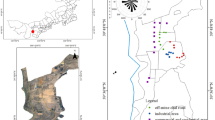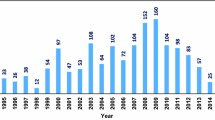Abstract
Near-surface atmospheric dust in Changsha city of China was analyzed in terms of morphological and geochemical composition. Morphological and chemical composition of the dust particles were analyzed by environmental scanning electron microscopy coupled with an energy-dispersive X-ray analyzer. Results indicated that the atmospheric dusts were mainly composed of spherule, plate, irregularly shaped and agglomerate, which contains variable sizes and amounts of particles. The dust particles could be categorized into five groups based on their chemical characteristic: Al-, Si-, Ca-, C-rich particles and aggregate. These particles and aggregate could be directly related to nearby polluting activities, such as building construction, traffic emission and coal combustion. The X-ray diffraction results show that the main minerals for atmospheric dust are gypsum, quartz and calcite. Mica, halloysite, montmorillonite, hematite, brushite, zeolite, sepiolite, feldspar, alite, dickite, SiS2, Fe6(OH)2CO3, FeSO4, CdSO4, Pb(NO)2O3, Al2SO4(OH)4, As2O3SO3, (NH4)2SO4, NH4Cl, K(NH4)·Ca(SO4)2·H2O are also detected in samples. The identification of heavy metals shows that the concentrations of Cr (403.5 mg kg−1), Cu (126 mg kg−1), Zn (1541.5 mg kg−1), Cd (2.5 mg kg−1) and Pb (348 mg kg−1) in the atmospheric dust are much higher compared to background value of soil. It indicates that the heavy metal (Cr, Cu, Zn, Cd and Pb) in the atmospheric dust is mainly due to human activities. The identification of main sources of atmospheric dust collected in typical areas can help to control the polluting sources in urban area.




Similar content being viewed by others
References
Adamo P, Giordano S, Naimo D, Bargagli R (2008) Geochemical properties of airborne particulate matter (PM10) collected by automatic device and biomonitors in a Mediterranean urban environment. Atmos Environ 42:346–357
Alastuey A, Querol X, Rodríguez S, Plana F, Lopez-Soler A, Ruiz C, Mantilla E (2004) Monitoring of atmospheric particulate matter around sources of secondary inorganic aerosol. Atmos Environ 38:4979–4992
AL-Rajhi MA, AL-Shayeb SM, Seaward MRD, Edwards HGM (1996) Particle size effect for metal pollution analysis of atmospherically deposited dust. Atmos Environ 30:145–153
Arditsoglou A, Samara C (2005) Levels of total suspended particulate matter and major trace elements in Kosovo: a source identification and apportionment study. Chemosphere 59:669–678
Bernabe′ GM, Carretero MI, Galan E (2005) Mineralogy and origin of atmospheric particles in the industrial area of Huelva (SW Spain). Atmos Environ 39:6777–6789
Bogo H, Otero M, Castro P, Ozafra′n MJ, Kreiner A, Calvo EJ, Negri RM (2003) Study of atmospheric particulate matter in Buenos Aires city. Atmos Environ 37:1135–1147
Boix A, Jordan M, Querol X, Sanfeliu T (2001) Characterization of total suspended particles around a power station in an urban coastal area in eastern Spain. Environ Geol 40:891–896
Chancey RT, Stutzman P, Juenger MCG, Fowler DW (2010) Comprehensive phase characterization of crystalline and amorphous phases of a Class F fly ash. Cement Concrete Res 40:146–156
Dybing E, Løvdal T, Hetland RB, Løvik M, Schwarze PE (2004) Respiratory allergy adjuvant and inflammatory effects of urban ambient particles. Toxicology 198:307–314
Espinosa AJF, Rodríguez MT, Rosa FJB, Sánchez JCJ (2002) A chemical speciation of trace metals for fine urban Particles. Atmos Environ 36:773–780
Fernandez-Turiel JL, Georgakopoulos A, Gimeno D, Papastergios G, Kolovos N (2004) Ash deposition in a pulverized coal-Wred power plant after high-calcium lignite combustion. Energy Fuels 18:1512–1518
Guo ZH, Xiao YY, Chen TB, Liao XY, Song J, Wu B (2008) Heavy metal pollution of soils and vegetables in the midstream and downstream of the Xiangjiang river, Hunan Province. J Geogr Sci 18:353–362
Harrison RM, Yin JX (2000) Particulate matter in the atmosphere: which particle properties are important for its effects on health? Sci Total Environ 249:85–101
Hoffman RC, Laskin A, Finlayson-Pitts BJ (2004) Sodium nitrate particles: physical and chemical properties during hydration and dehydration, and implications for aged sea salt aerosols. J Aerosol Sci 35:869–887
Iordanidis A, Buckman J, Triantafyllou AG, Asvesta A (2008) ESEM-EDX characterisation of airborne particles from an industrialised area of northern Greece. Environ Geochem Health 30:391–405
Jones T, Moreno T, BéruBé K, Richards R (2006) The physicochemical characterization of microscopic airborne particles in South Wales: A review of the locations and methodologies. Sci Total Environ 360:43–59
Kasparian J, Frejafon E, Rambaldi P, Yu J, Vezin B, Wolf JP, Ritter P, Viscardi P (1998) Characterization of urban aerosols using semi-microscopy, X-ray analysis and Lidar measurements. Atmos Environ 32:2957–2967
Krueger BJ, Grassian VH, Cowin JP, Laskin A (2004) Heterogeneous chemistry of individual mineral dust particles from different dust source regions: the importance of particle mineralogy. Atmos Environ 38:6253–6261
Long YZ, Dai TG, Zou HY (2008) Geochemistry Features of Accumulated Dust in Changsha, Zhuzhou and Xiangtan. Nat Sci J Xiangtan Univ 30:4
Lu SG, Zheng YW, Bai SQ (2008) A HRTEM/EDX approach to identification of the source of dust particles on urban tree leaves. Atmos Environ 42:6431–6441
Mohanral R, Azeez PA, Priscilla T (2004) Heavy metal in airborne particulate matter of urban Coimbatore. Environ Contam Toxicol 47:162–167
Paoletti L, Berardis BD, Diociaiuti M (2002) Physicochemical characterization of the inhalable particulate matter (PM10) in an urban area: An analysis of the seasonal trend. Sci Total Environ 292:265–275
Prajapati SK, Pandey SK, Tripathi BD (2006) Monitoring of vehicles derived particulates using magnetic properties of leaves. Environ Monit Assess 120:169–175
Querol X, Alastuey A, Lopez-Soler A, Mantillai E, Plana F (1996) Mineral composition of atmospheric particulates around a large coal-fired power station. Atmos Environ 30:3557–3572
Samet JM, Dominici F, Curriero FC, Coursac I, Zeger SL (2000) Fine particulate air pollution and mortality in 20 US cities, 1987–1994. N Engl J Med 343:1742–1749
Shao LY, Li WJ, Yang SS, Shi ZB, Lu SL (2002) Mineralogical characteristics of airborne particles collected in Beijing during a severe Asian dust storm period in spring 2002. Science in China Series D: Earth Sci 50:953–959
Sturges WT, Harrison RM (1989) Semi-quantitative X-ray diffraction analysis of size fractionated atmospheric particles. Atmos Environ 23:1083–1098
Suzuki K (2006) Characterisation of airborne particulates and associated trace metals deposited on tree bark by ICP-OES, ICP-MS, SEM-EDX and laser ablation ICP-MS. Atmos Environ 40:2626–2634
Trimbacher C, Weiss P (1999) Needle surface characteristics and element contents of Norway spruce in relation to the distance of emission sources. Environ Pollut 105:111–119
Utsunomiya S, Ewing RC (2003) Application of high-angle annular dark field scanning transmission electron microscopy, scanning transmission electron microscopy energy-dispersive X-ray spectrometry, and energy-filtered transmission electron microscopy to the characterization of nanoparticles in the environment. Environ Sci Technol 37:786–791
Vallius M, Janssen NAH, Heinrich J, Hoek G, Ruuskanen J, Cyrys J, Grieken RV, Hartog JJ, Kreyling WG, Pekkanen J (2005) Sources and elemental composition of ambient PM2.5 in three European cities. Sci Total Environ 33:147–162
Varrica D, Dongarrà G, Sabatino G, Monna F (2003) Inorganic geochemistry of roadway dust from the metropolitan area of Palermo, Italy. Env Geol 44:222–230
Vassilev SV, Vassileva CG (1996) Mineralogy of combustion wastes from coal-fired power stations. Fuel Process Technol 47:261–280
Ward CR, French D (2005) Relation Between Coal and Fly Ash Mineralogy Based on Quantitative X- ray Diffraction Methods, World of Coal Ash Conference, World of Coal Ash, Lexington, KY. Accessed Online: http://www.flyash.info/209war.pdf
Zhang RJ, Han ZW, Cheng TT, Tao J (2009) Chemical properties and origin of dust aerosols in Beijing during springtime. Particuology 7:61–67
Zhao PS, Feng YC, Zhu T, Wu JH (2006) Characterizations of resuspended dust in six cities of North China. Atmos Environ 40:5807–5814
Acknowledgments
This work was supported by National Natural Science Foundation of China (50908080), Hunan Provincial Natural Science Foundation of China (11JJ2032) and the Fundamental Research Funds for the Central Universities and Supported by Doctoral Fund of Ministry of Education of China (Grant No. 20090161120042), the Project of Humanities and Social Sciences of Chinese Ministry of Education (Grant No. 09YJC790078). The authors would like to express their gratitude to Materials Testing Center Hunan University for providing testing instruments.
Author information
Authors and Affiliations
Corresponding author
Rights and permissions
About this article
Cite this article
Fu, Z., Zhai, Y., Wang, L. et al. Morphological, geochemical composition and origins of near-surface atmospheric dust in Changsha city of China. Environ Earth Sci 66, 2207–2216 (2012). https://doi.org/10.1007/s12665-011-1442-9
Received:
Accepted:
Published:
Issue Date:
DOI: https://doi.org/10.1007/s12665-011-1442-9




